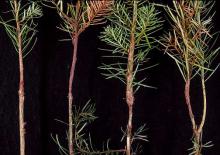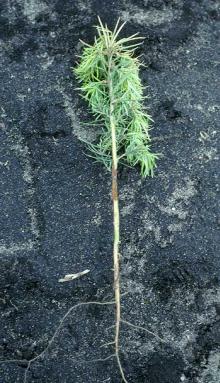Cause The fungus Phoma eupyrena is associated with three different diseases called upper stem canker, lower stem canker, and Phoma blight. The fungus can survive in soil by forming chlamydospores and machinery or blowing soil can transport spores to uninfected areas. Upper stem canker infection occurs when spores land in bark fissures caused by rapid seedling growth. Infection for the other two diseases occurs below the soil collar, which builds up from rain or irrigation-splashed soil. In the case of Phoma blight, the fungus enters through lower needles from this soil collar. Seedlings weakened by nutrient imbalances, such as excessive calcium and iron, are especially susceptible. Lower stem canker damage is in areas with poor drainage and spreads within beds more rapidly than between beds. Fusarium spp. are also involved with lower stem canker.
Upper stem canker is primarily a disease of Douglas-fir seedlings in bareroot nurseries in western Oregon and Washington. Lower stem canker also occurs on Douglas-fir seedlings and occasionally on noble fir in bareroot nurseries in the same locations. Phoma blight occurs at a low level in nurseries throughout the PNW including Idaho.
Upper stem canker occurs primarily in the fall of the 1+0 year, kills only seeding tops and is readily controlled with fungicides. Lower stem canker occurs only in the spring of the 2+0 year, kills the entire seedling, and is not controlled with fungicides. Phoma blight occurs kills needles and buds without a stem canker and is best controlled with mulches.
Symptoms Upper stem canker - Seedling tops turn chlorotic and then red-brown in late September or October of the first growing season. Cankers can be found on the middle to upper stem. The canker is at first sunken and centered on a bark fissure; then it expands around the stem and turns red-brown. Black pycnidia may be in the canker.
Lower stem canker - Lower needles begin to turn brown in late winter or early spring. Tops of infected seedlings turn yellow and later red-brown. Look for a girdling canker under the soil collar.
Phoma blight - Chlorotic and necrotic foliage, tip dieback, defoliation, and mortality of bareroot seedlings.
Cultural control
- Avoid overfertilization or late irrigation that may extend growth into fall.
- Grow seedlings at lower densities.
- Use mulches that reduce the buildup of soil (collar or cone) around the base of the seedling.
- Allow moss to build up on seed beds, which also reduces soil collars.
- Improve soil drainage and minimize soil compaction.
Chemical control Apply at 2-week intervals from mid-July to bud set in the fall to manage upper stem canker.
- Bravo Weather Stik at 1.5 to 2.75 pints/A. Group M5 fungicide. 12-hr reentry.
Reference Cordell, C.E., Anderson, R.L., Hoffard, W.H., Landis, T.D., Smith, R.S., and Toko, H.V. 1989. Forest Nursery Pests. USDA Agriculture Handbook 680.




